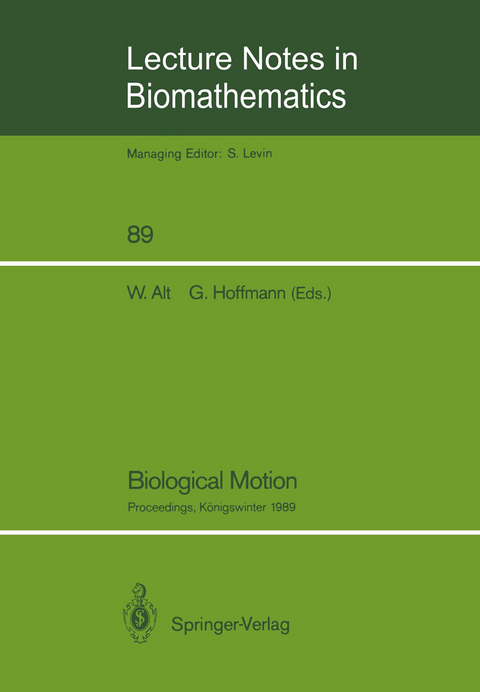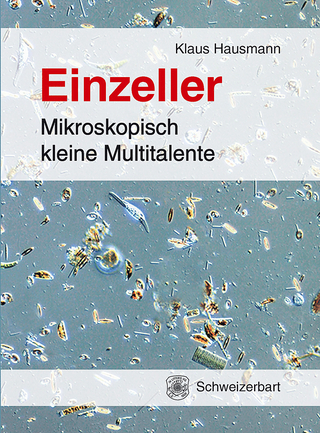
Biological Motion
Springer Berlin (Verlag)
978-3-540-53520-1 (ISBN)
Motion of Cell or Body Parts.- Quantifying Cellular Shape Using Moment Invariants.- Analysis of Leucocyte Shape Changes.- Images of Cells Changing Shape: Pseudopods, Skeletons and Motile Behaviour.- Continuity of Movement and Preservation of Architecture during Cell Locomotion.- Periodic Contraction Waves in Cytoplasmic Extracts.- Motion Analysis of Intracellular Objects: Trajectories with and without Visible Tracks.- Centrin-Mediated Cell Motility in Eukariotic Cells.- Descriptive and Mechanistic Models of Flagellar Motility.- Discrete Nature of Flagellar Bending Detected by Digital Image Analysis.- An Approach to Quantitative Analysis and Modelling of Three-Dimensional Ciliary Motion.- Bioelectric Control of the Ciliary Cycle.- Ca-Mg Control of Ciliary Motion: A Quantitative Model Study.- Modelling the Control of Walking in Insects.- Coordination of Contralateral Legs in Walking Crayfish.- Flight Manoeuvres of Locusts.- How a Fish's Brain May Move a Fish's Body.- Locomotion of Single Organisms.- Correlation Analysis of Two-Dimensional Locomotion Paths.- Paths of Carabid Beetles Walking in the Absence of Orienting Stimuli and the Time Structure of their Motor Output.- Microzooplankton Feeding Behavior and the Levy Walk.- Adaptation and Orientation in Animals' Movements: Random Walk, Kinesis, Taxis and Path-Integration.- The Site Independent Information that an Isopod Uses for Homing.- A Simulation Model of Foraging Excursions in Intertidal Chitons.- How to Describe the Search of a Predator for Patchily Distributed Prey?.- Tracking of Flagellates by Image Analysis.- Helical Orientation - A Novel Mechanism for the Orientation of Microorganisms.- Motile Behaviour and Determination of the Magnetic Moment of Magnetic Bacteria in Rotating Magnetic Fields.-Chemokinesis, Chemotaxis and Galvanotaxis Dose-Response Curves and Signal Chains.- Models of Chemical Gradient Sensing by Cells.- Endothelial Cell Chemotaxis in Angiogenesis.- A Model for Trail Following in Ants: Individual and Collective Behaviour.- Definition and Measurement of Cell Migration Coefficients.- Signals for Chemotaxis and Chemokinesis in Cells of Dictyostelium Discoideum.- Distinction Between Kinesis and Taxis in Terms of System Theory.- Collective Motion.- Functional Self-Organisation Illustrated by Inter-Nest Traffic in Ants: The Case of the Argentine Ant.- Simulations of the Gliding Behavior and Aggregation of Myxobacteria.- A One Dimensional Model for the Swarming Behavior of Myxobacteria.- From Cell to Tissue; Contact Mediated Orientation Selection in a Population.- The Movement of Fish Schools: A Simulation Model.
| Erscheint lt. Verlag | 12.2.1991 |
|---|---|
| Reihe/Serie | Lecture Notes in Biomathematics |
| Zusatzinfo | X, 607 p. 78 illus. |
| Verlagsort | Berlin |
| Sprache | englisch |
| Maße | 170 x 244 mm |
| Gewicht | 1052 g |
| Themenwelt | Mathematik / Informatik ► Mathematik |
| Naturwissenschaften ► Biologie ► Zellbiologie | |
| Schlagworte | Calculus • Function • Invariant • Mathematica |
| ISBN-10 | 3-540-53520-9 / 3540535209 |
| ISBN-13 | 978-3-540-53520-1 / 9783540535201 |
| Zustand | Neuware |
| Haben Sie eine Frage zum Produkt? |
aus dem Bereich


